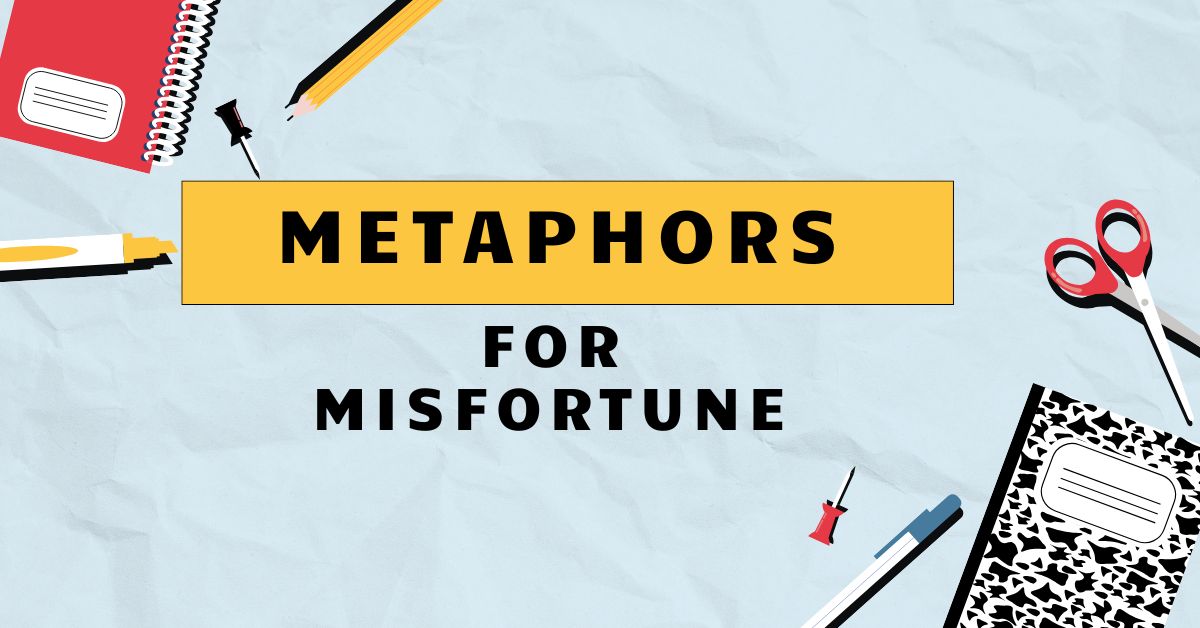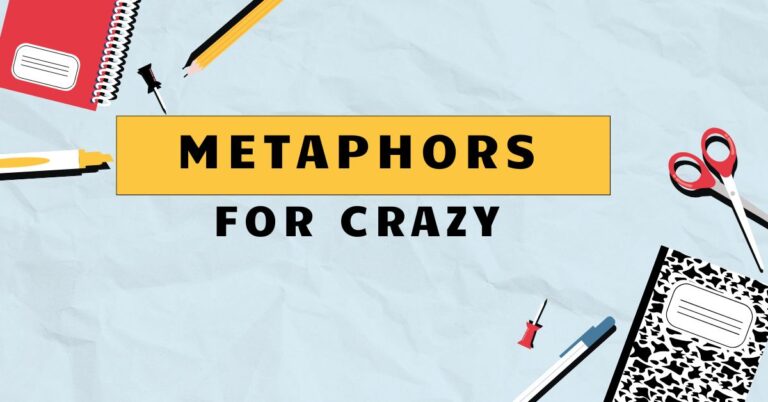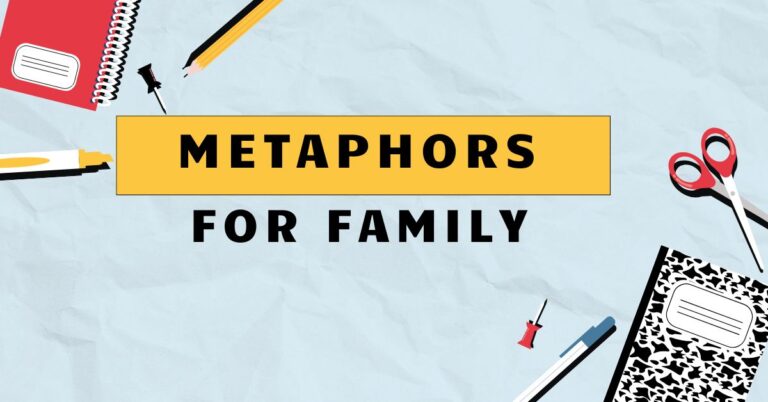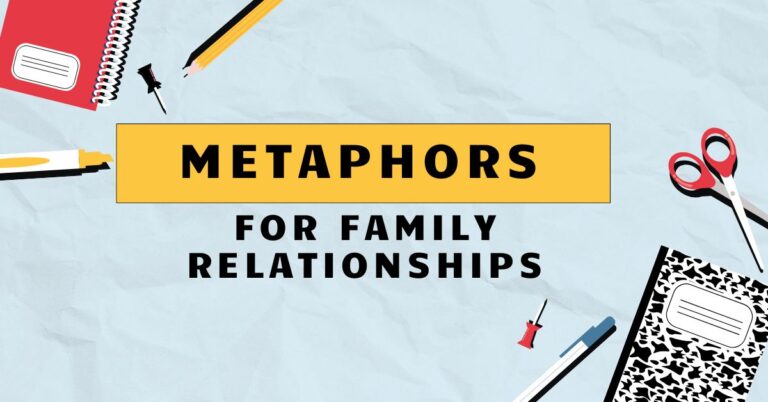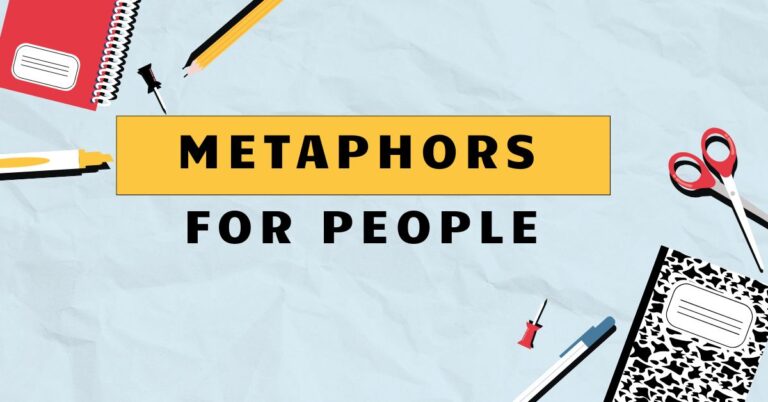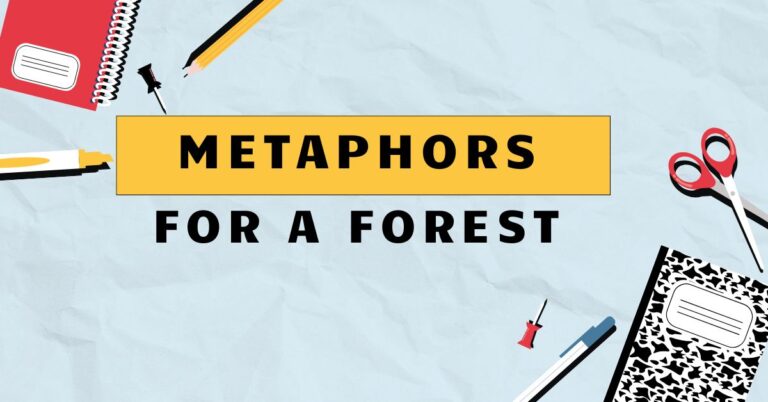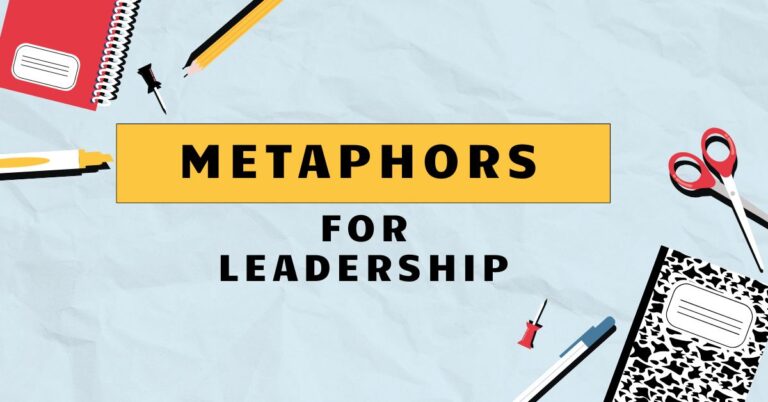33 Metaphors for Misfortune: Understanding Figurative Language
Metaphors are powerful tools in the English language, allowing us to express complex ideas and emotions in vivid and relatable ways. Understanding metaphors, especially those used to describe negative situations or misfortunes, is crucial for comprehending both literature and everyday conversation.
This knowledge not only enhances our reading comprehension but also enriches our own communication skills. This article will explore the various types of metaphors used to depict bad things, providing examples, usage rules, and practice exercises to help you master this aspect of figurative language.
Whether you are an English language learner, a student of literature, or simply someone looking to improve their communication skills, this guide will provide valuable insights.
Table of Contents
- Introduction
- Definition of Metaphor
- Structural Breakdown of Metaphors
- Types of Metaphors for Bad Things
- Examples of Metaphors for Bad Things
- Usage Rules for Metaphors
- Common Mistakes with Metaphors
- Practice Exercises
- Advanced Topics
- Frequently Asked Questions
- Conclusion
Definition of Metaphor
A metaphor is a figure of speech that directly compares two unrelated things, asserting that one thingisanother. Unlike similes, which use words like “like” or “as” to make a comparison, metaphors create a more direct and often more powerful connection.
Metaphors are used to add color, depth, and emotional resonance to language, allowing speakers and writers to convey abstract ideas in concrete and relatable terms.
Classification of Metaphors
Metaphors can be classified in several ways, including by their level of explicitness and their conventionality. Some metaphors are explicit, clearly stating the comparison, while others are implicit, leaving the comparison to be inferred by the reader. Conventional metaphors are those that have become widely accepted and understood through repeated use, while novel metaphors are fresh and original, creating a new perspective on the subject.
Function of Metaphors
The primary function of a metaphor is to transfer qualities from one thing to another, creating a new understanding of the target concept. Metaphors can be used to simplify complex ideas, evoke emotions, and create vivid imagery.
They are essential tools for persuasion, storytelling, and creative expression. By drawing connections between seemingly disparate things, metaphors allow us to see the world in new and insightful ways.
Contexts of Metaphorical Usage
Metaphors are used in virtually every context of communication, from everyday conversations to literature, poetry, and scientific discourse. In literature, metaphors can add layers of meaning and symbolism to a text.
In scientific writing, metaphors can help to explain complex concepts to a wider audience. In everyday speech, metaphors can make our language more engaging and expressive.
The effectiveness of a metaphor often depends on the context in which it is used and the audience to whom it is addressed.
Structural Breakdown of Metaphors
A metaphor typically consists of two main elements: thetenor(or subject) and thevehicle. The tenor is the thing being described, while the vehicle is the thing to which it is being compared.
The vehicle carries the qualities that are being attributed to the tenor. For example, in the metaphor “Life is a journey,” “life” is the tenor and “journey” is the vehicle.
The qualities of a journey (e.g., challenges, discoveries, destinations) are being used to describe the experience of life.
Understanding the relationship between the tenor and the vehicle is crucial for interpreting metaphors effectively. The connection between the two may be based on shared characteristics, emotional associations, or cultural understandings.
A successful metaphor creates a resonance between the tenor and the vehicle, illuminating the tenor in a new and meaningful way. The strength of a metaphor often lies in its ability to surprise and challenge our assumptions.
Types of Metaphors for Bad Things
Metaphors for bad things can be categorized based on the domains from which they draw their imagery. These include nature, war, disease, weather, darkness, and burdens.
Each category offers a unique perspective on misfortune, highlighting different aspects of negative experiences.
Nature-Related Metaphors
Nature-related metaphors often depict bad things as natural disasters, harsh landscapes, or destructive forces. These metaphors can convey a sense of inevitability, uncontrollability, and overwhelming power.
Examples include “a storm of emotions,” “a barren wasteland of despair,” and “a treacherous path.” These metaphors tap into our primal understanding of nature’s power and unpredictability.
War and Conflict Metaphors
War and conflict metaphors frame bad things as battles, struggles, or conflicts. These metaphors emphasize the adversarial nature of the experience, highlighting the effort, pain, and potential for loss involved.
Examples include “a battle with depression,” “a war against poverty,” and “a constant struggle for survival.” These metaphors often evoke a sense of urgency and determination.
Disease and Illness Metaphors
Disease and illness metaphors portray bad things as ailments, infections, or conditions that weaken and debilitate. These metaphors can convey a sense of vulnerability, suffering, and the need for healing.
Examples include “a cancer of corruption,” “a plague of despair,” and “a virus of hatred.” These metaphors often highlight the insidious and pervasive nature of negative forces.
Weather-Related Metaphors
Weather-related metaphors use elements like storms, clouds, or droughts to describe negative situations. These metaphors often highlight the temporary or cyclical nature of bad times.
Examples include “a dark cloud hanging over him,” “a drought of creativity,” and “a storm of controversy.” These metaphors can evoke feelings of anxiety, uncertainty, and the hope for eventual clearing.
Darkness and Shadow Metaphors
Darkness and shadow metaphors associate bad things with the absence of light, suggesting obscurity, fear, and hidden dangers. These metaphors often convey a sense of mystery, uncertainty, and the unknown.
Examples include “a dark secret,” “a shadow of doubt,” and “a descent into darkness.” These metaphors tap into our primal fear of the unseen and the unknown.
Burden and Weight Metaphors
Burden and weight metaphors describe bad things as heavy loads, oppressive weights, or unbearable burdens. These metaphors emphasize the strain, exhaustion, and difficulty associated with negative experiences.
Examples include “the weight of the world on his shoulders,” “a heavy heart,” and “the burden of responsibility.” These metaphors often evoke feelings of empathy and understanding.
Examples of Metaphors for Bad Things
The following tables provide examples of metaphors for bad things, organized by category. Each example illustrates how a specific type of metaphor can be used to describe a negative situation or experience.
Nature-Related Examples
This table showcases nature-related metaphors. These metaphors draw parallels between negative situations and aspects of the natural world that evoke feelings of danger, destruction, or desolation.
| Metaphor | Explanation |
|---|---|
| The project was a swamp of bureaucratic delays. | The project is being compared to a swamp, suggesting it’s bogged down and difficult to navigate. |
| Her anger was a volcano about to erupt. | Her anger is likened to a volcano, implying a sudden and explosive release of pent-up emotions. |
| The scandal created a tsunami of negative publicity. | The scandal is compared to a tsunami, indicating an overwhelming and destructive wave of attention. |
| His life had become a desert of loneliness. | His life is described as a desert, suggesting a barren and desolate existence devoid of companionship. |
| The company was navigating a jungle of regulations. | The company’s situation is likened to a jungle, implying a complex and challenging environment. |
| The rumor spread like wildfire through the town. | The rumor is compared to wildfire, suggesting it spread rapidly and uncontrollably. |
| The argument became a forest fire, consuming everything in its path. | The argument is likened to a forest fire, indicating widespread and destructive consequences. |
| His dreams were a wasteland after the failure. | His dreams are described as a wasteland, suggesting a barren and unproductive state. |
| The negotiation was a minefield of potential disagreements. | The negotiation is compared to a minefield, implying hidden dangers and risks. |
| Their relationship was a cliff, ready to crumble. | Their relationship is likened to a cliff, suggesting instability and impending collapse. |
| The political climate was a glacial landscape, slow and unchanging. | The political climate is compared to a glacial landscape, indicating stagnation and resistance to change. |
| His heart was a stone after years of heartbreak. | His heart is described as a stone, suggesting a lack of emotion and empathy. |
| The stock market crash was an earthquake that shook the financial world. | The stock market crash is likened to an earthquake, implying a sudden and devastating impact. |
| The project became a black hole, sucking up all resources. | The project is compared to a black hole, suggesting it consumes resources without providing any return. |
| Her career was a thorn in his side, constantly irritating him. | Her career is described as a thorn, suggesting a persistent source of annoyance. |
| The legal battle was a quagmire, difficult to escape. | The legal battle is likened to a quagmire, indicating a complex and inescapable situation. |
| His past mistakes were a shadow that followed him everywhere. | His past mistakes are compared to a shadow, suggesting a persistent and inescapable reminder of his errors. |
| The news was a bomb that shattered their peace. | The news is described as a bomb, implying a sudden and devastating impact. |
| The company’s reputation was a house of cards, easily toppled. | The company’s reputation is likened to a house of cards, suggesting fragility and vulnerability. |
| The project was a slippery slope towards failure. | The project is compared to a slippery slope, indicating a gradual and uncontrolled decline. |
| The company was drowning in a sea of debt. | The company’s financial situation is likened to drowning in a sea, indicating being overwhelmed by debt. |
| His words were a dagger to her heart. | His words are described as a dagger, suggesting a sharp and painful emotional impact. |
| The problem was a knot that she couldn’t untangle. | The problem is compared to a knot, implying complexity and difficulty in resolving it. |
War and Conflict Examples
This table presents war and conflict metaphors. These metaphors frame negative situations as battles, struggles, or conflicts, emphasizing the effort, pain, and potential for loss involved.
| Metaphor | Explanation |
|---|---|
| He was locked in a battle with his inner demons. | He is portrayed as fighting a battle against his internal struggles. |
| The company was waging a war against its competitors. | The company’s competitive efforts are likened to a war. |
| She was fighting a losing battle against the disease. | Her struggle against the disease is described as a battle that she is likely to lose. |
| The negotiation became a hostage situation. | The negotiation is compared to a hostage situation, indicating high stakes and potential danger. |
| His career was a minefield of political maneuvering. | His career environment is likened to a minefield, implying hidden dangers and risks. |
| The project was a skirmish in a larger corporate war. | The project is described as a minor conflict within a larger organizational struggle. |
| Their relationship was a cold war, filled with unspoken tension. | Their relationship is likened to a cold war, suggesting a state of tension without open conflict. |
| The argument escalated into a full-blown assault. | The argument is compared to a full-blown assault, indicating a violent and aggressive exchange. |
| The company was under siege from activist investors. | The company is described as being under siege, suggesting it is being heavily pressured. |
| His words were ammunition in their ongoing feud. | His words are likened to ammunition, implying they fuel the conflict. |
| The debate turned into a verbal brawl. | The debate is compared to a verbal brawl, indicating a chaotic and aggressive exchange. |
| She was a prisoner of her own fears. | She is described as a prisoner, suggesting she is trapped by her own anxieties. |
| The merger was a takeover by the larger company. | The merger is likened to a takeover, implying one company dominating the other. |
| His life was a constant struggle for survival. | His life is described as a constant struggle, suggesting ongoing hardship. |
| The election was a battleground for competing ideologies. | The election is compared to a battleground, indicating a fierce competition of ideas. |
| Their relationship was a power struggle. | Their relationship is likened to a power struggle, suggesting a competition for dominance. |
| The project was a sabotage of their efforts. | The project is described as a sabotage, implying deliberate undermining. |
| He was a casualty of the corporate restructuring. | He is described as a casualty, suggesting he suffered as a result of the restructuring. |
| The company was defending its market share. | The company’s efforts are likened to defending a territory. |
| The legal case was a war of attrition. | The legal case is compared to a war of attrition, indicating a prolonged and exhausting battle. |
| He was a soldier in the fight against poverty. | He is described as a soldier, suggesting his dedication to the cause. |
| The company was bombarded with complaints. | The company is described as being bombarded, suggesting it received a large number of complaints. |
| The project was a strategic retreat after the setbacks. | The project’s change in direction is likened to a strategic retreat. |
Disease and Illness Examples
This table provides disease and illness metaphors. These metaphors portray negative situations as ailments, infections, or conditions that weaken and debilitate.
| Metaphor | Explanation |
|---|---|
| Corruption is a cancer that eats away at society. | Corruption is likened to cancer, suggesting it destroys society from within. |
| Gossip is a virus that spreads quickly through the office. | Gossip is compared to a virus, indicating its rapid and contagious spread. |
| His anger was a fever that consumed him. | His anger is described as a fever, suggesting it is intense and overwhelming. |
| The company was suffering from a disease of mismanagement. | The company’s problems are likened to a disease, indicating systemic issues. |
| Her sadness was a chronic condition that never fully healed. | Her sadness is compared to a chronic condition, suggesting it is long-lasting and persistent. |
| The project was infected with problems from the start. | The project is described as being infected, suggesting it is riddled with issues. |
| Their relationship was toxic, poisoning their happiness. | Their relationship is likened to something toxic, indicating it is harmful and destructive. |
| His mind was a hospital for broken dreams. | His mind is compared to a hospital, suggesting it is filled with pain and suffering. |
| The city was plagued by unemployment. | The city is described as being plagued, suggesting it is severely affected by unemployment. |
| His heart was scarred by past relationships. | His heart is likened to being scarred, suggesting lasting emotional damage. |
| The political system was sick with corruption. | The political system is compared to being sick, indicating widespread corruption. |
| Her spirit was wounded by the criticism. | Her spirit is described as being wounded, suggesting she was deeply hurt. |
| The company was paralyzed by indecision. | The company is likened to being paralyzed, suggesting it is unable to act. |
| His hope was a fragile patient in need of constant care. | His hope is compared to a fragile patient, suggesting it is easily damaged. |
| The project was a headache from beginning to end. | The project is described as a headache, suggesting it was consistently annoying and problematic. |
| Their marriage was on life support. | Their marriage is likened to being on life support, suggesting it is barely surviving. |
| His conscience was numb after years of wrongdoing. | His conscience is described as being numb, suggesting a lack of moral feeling. |
| The situation was a pain that wouldn’t go away. | The situation is compared to a pain, suggesting it is persistently unpleasant. |
| His words were a poison that destroyed their trust. | His words are likened to poison, indicating they are harmful and destructive. |
| The rumor was a disease that spread through the community. | The rumor is compared to a disease, suggesting it is contagious and harmful. |
| The company’s finances were in a coma. | The company’s financial situation is likened to a coma, indicating a state of inactivity and potential danger. |
| His memories were a ghost that haunted him. | His memories are described as a ghost, suggesting they are persistent and distressing. |
| The problem was a blight on their reputation. | The problem is compared to a blight, suggesting it damages their reputation. |
Weather-Related Examples
This table presents weather-related metaphors. These metaphors use elements like storms, clouds, or droughts to describe negative situations, often highlighting the temporary or cyclical nature of bad times.
| Metaphor | Explanation |
|---|---|
| A storm of criticism followed the announcement. | The criticism is likened to a storm, suggesting it was intense and overwhelming. |
| He was under a cloud of suspicion. | He is described as being under a cloud, suggesting he is suspected of wrongdoing. |
| The company was experiencing a drought of innovation. | The company’s lack of innovation is likened to a drought. |
| Her tears were a flood of emotion. | Her tears are compared to a flood, indicating an overwhelming release of emotion. |
| The market was in a deep freeze after the crash. | The market’s inactivity is likened to a deep freeze. |
| His mood was sunny one moment and stormy the next. | His mood is described as fluctuating between positive and negative extremes. |
| The project was fogged in by uncertainty. | The project is likened to being fogged in, suggesting a lack of clarity and direction. |
| His anger was a hurricane of rage. | His anger is compared to a hurricane, indicating its destructive power. |
| The business was weathering a long winter of economic hardship. | The business’s difficult period is likened to a long winter. |
| His hopes were drowning in a sea of despair. | His hopes are described as drowning, suggesting they are being overwhelmed by despair. |
| The atmosphere was charged with tension. | The atmosphere is likened to being charged, suggesting a high level of tension. |
| The project was a whirlwind of activity. | The project is compared to a whirlwind, indicating a chaotic and fast-paced environment. |
| The company was caught in a perfect storm of bad luck. | The company’s situation is likened to a perfect storm, suggesting a combination of unfortunate events. |
| His enthusiasm was dampened by the criticism. | His enthusiasm is described as being dampened, suggesting it was reduced by criticism. |
| The scandal was a thunderbolt that shook the industry. | The scandal is compared to a thunderbolt, indicating a sudden and shocking impact. |
| Their relationship was overcast with sadness. | Their relationship is likened to being overcast, suggesting a pervasive sadness. |
| His spirit was parched from a lack of inspiration. | His spirit is described as being parched, suggesting a lack of creativity and motivation. |
| The news was a cold front that chilled their spirits. | The news is compared to a cold front, suggesting it was unwelcome and disheartening. |
| The project was a blizzard of paperwork. | The project is likened to a blizzard, indicating an overwhelming amount of paperwork. |
| The economy was going through a rough patch. | The economy’s difficulty is described as a rough patch. |
| The company was navigating a torrent of challenges. | The company’s situation is likened to navigating a torrent, indicating a large number of challenges. |
| His words were a gentle rain after a long drought. | His words are compared to a gentle rain, suggesting they were refreshing and welcome. |
| The situation was a heat wave of stress. | The situation is likened to a heat wave, indicating a period of intense stress. |
Darkness and Shadow Examples
This table presents darkness and shadow metaphors. These metaphors associate bad things with the absence of light, suggesting obscurity, fear, and hidden dangers.
| Metaphor | Explanation |
|---|---|
| His past was a dark secret that haunted him. | His past is described as a dark secret, suggesting it is hidden and troubling. |
| She lived in the shadow of her older brother’s success. | She is described as living in the shadow, suggesting she is overshadowed by her brother. |
| The company was operating in the dark about the financial risks. | The company is described as operating in the dark, suggesting it lacks information. |
| His future looked bleak and uncertain. | His future is described as bleak, suggesting it is unpromising. |
| The project was shrouded in mystery. | The project is described as shrouded in mystery, suggesting it is difficult to understand. |
| He was lost in a fog of confusion. | He is described as being lost in a fog, suggesting he is disoriented. |
| Their relationship was a twilight of fading affection. | Their relationship is likened to twilight, suggesting a decline in affection. |
| His hope was a dim light in a dark tunnel. | His hope is compared to a dim light, suggesting it is faint but still present. |
| The city was a grey landscape of despair. | The city is described as a grey landscape, suggesting it is depressing and lifeless. |
| His words cast a shadow of doubt on her honesty. | His words are described as casting a shadow, suggesting they raise questions about her honesty. |
| The situation was a black hole of despair. | The situation is likened to a black hole, suggesting it is consuming all hope. |
| He was walking on the dark side of the law. | He is described as walking on the dark side, suggesting he is engaging in illegal activities. |
| Her dreams were eclipsed by her responsibilities. | Her dreams are described as being eclipsed, suggesting they are overshadowed by her duties. |
| The scandal revealed the underbelly of the industry. | The scandal is described as revealing the underbelly, suggesting it exposed the hidden corruption. |
| He was a shadow of his former self. | He is described as a shadow, suggesting he is diminished compared to his past self. |
| Their secrets were buried in the dark recesses of their minds. | Their secrets are likened to being buried in dark recesses, suggesting they are deeply hidden. |
| His future was a blank canvas, filled with uncertainty. | His future is compared to a blank canvas, suggesting it is undefined and uncertain. |
| The project was a shot in the dark. | The project is described as a shot in the dark, suggesting it is a long shot with little chance of success. |
| The truth was hidden in the shadows of deception. | The truth is described as being hidden in the shadows, suggesting it is concealed by dishonesty. |
| He was a lone wolf, wandering in the darkness. | He is described as a lone wolf, suggesting he is isolated and alone. |
| The company was operating under a veil of secrecy. | The company is likened to operating under a veil, suggesting it is concealing its activities. |
| His past mistakes were a dark cloud hanging over his head. | His past mistakes are compared to a dark cloud, suggesting they are a constant reminder of his errors. |
| Their relationship was a flickering candle in the wind. | Their relationship is likened to a flickering candle, suggesting it is fragile and unstable. |
Burden and Weight Examples
This table presents burden and weight metaphors. These metaphors describe bad things as heavy loads, oppressive weights, or unbearable burdens, emphasizing the strain, exhaustion, and difficulty associated with negative experiences.
| Metaphor | Explanation |
|---|---|
| He carried the weight of the world on his shoulders. | He is described as bearing a heavy burden of responsibility. |
| She had a heavy heart after the loss. | She is described as having a heavy heart, suggesting she is deeply saddened. |
| The company was saddled with debt. | The company is described as being saddled, suggesting it is burdened by debt. |
| He felt the pressure of expectations. | He is described as feeling pressure, suggesting he is burdened by expectations. |
| Her words were a burden on his conscience. | Her words are described as a burden, suggesting they weigh heavily on his mind. |
| The project was a drag on their resources. | The project is described as a drag, suggesting it is draining their resources. |
| He was weighed down by his responsibilities. | He is described as being weighed down, suggesting he is burdened by his duties. |
| The truth was a stone in his stomach. | The truth is compared to a stone, suggesting it is causing him discomfort. |
| The scandal was a millstone around their necks. | The scandal is likened to a millstone, suggesting it is dragging them down. |
| His past mistakes were a chain that held him back. | His past mistakes are described as a chain, suggesting they are preventing him from moving forward. |
| The responsibility was a yoke around his neck. | The responsibility is compared to a yoke
, suggesting it is restrictive and burdensome. |
| She was crushed by the weight of expectations. | She is described as being crushed, suggesting she is overwhelmed by expectations. |
| The company was bogged down in bureaucracy. | The company is described as being bogged down, suggesting it is hampered by bureaucracy. |
| His guilt was a heavy load to bear. | His guilt is compared to a heavy load, suggesting it is difficult to manage. |
| The decision was a cross to bear. | The decision is likened to a cross, suggesting it is a painful burden. |
| The company was overextended and struggling to cope. | The company is described as being overextended, suggesting it is stretched too thin. |
| He was burdened with the secret. | He is described as being burdened, suggesting he is carrying a heavy secret. |
| The project was a drain on their energy. | The project is compared to a drain, suggesting it is exhausting their energy. |
| His worries were a knot in his stomach. | His worries are likened to a knot, suggesting they are causing him anxiety. |
| The mistake was a blot on his record. | The mistake is compared to a blot, suggesting it is a stain on his reputation. |
| The criticism was a blow to his confidence. | The criticism is likened to a blow, suggesting it damaged his confidence. |
| He was weighted down by his past. | He is described as being weighted down, suggesting his past is holding him back. |
| The challenge was a mountain to climb. | The challenge is compared to a mountain, suggesting it is formidable and difficult to overcome. |
Usage Rules for Metaphors
Using metaphors effectively requires careful consideration of clarity, relevance, consistency, and cultural sensitivity. A well-chosen metaphor can enhance communication, while a poorly chosen one can confuse or offend.
Clarity and Relevance
A metaphor should be clear and easily understood by the audience. The connection between the tenor and the vehicle should be apparent, and the metaphor should be relevant to the context.
Avoid using obscure or overly complex metaphors that may confuse the reader or listener. The metaphor should illuminate the subject, not obscure it.
Consistency and Tone
Maintain a consistent tone and style throughout your writing or speech. Avoid mixing metaphors that create conflicting or nonsensical images.
The metaphor should align with the overall tone of the message, whether it is serious, humorous, or reflective. Inconsistent metaphors can undermine the credibility of the speaker or writer.
Avoiding Cliches
Cliches are overused metaphors that have lost their impact and originality. While they may be easily understood, they often fail to engage the audience or add new insight.
Strive to create fresh and original metaphors that offer a unique perspective on the subject. Avoid relying on tired expressions that have become commonplace.
Cultural Sensitivity
Be mindful of cultural differences and sensitivities when using metaphors. A metaphor that is appropriate in one culture may be offensive or misunderstood in another.
Consider the cultural background of your audience and choose metaphors that are universally understood or that are carefully explained to avoid misinterpretation. Avoid using metaphors that perpetuate stereotypes or cultural biases.
Common Mistakes with Metaphors
Several common mistakes can undermine the effectiveness of metaphors. These include using mixed metaphors, dead metaphors, and inappropriate metaphors.
Understanding these pitfalls can help you avoid them in your own writing and speech.
- Mixed Metaphors: Combining two or more incompatible metaphors, creating a nonsensical image.
“We need to nip it in the bud before it snowballs out of the park.”
“We need to nip it in the bud before it becomes a bigger problem.”
- Dead Metaphors: Using metaphors that have become so common that they have lost their figurative meaning.
“The heart of the matter is…”
“The central issue is…”
- Inappropriate Metaphors: Using metaphors that are offensive, insensitive, or simply do not fit the context.
“The refugees were a swarm of locusts.”
“The refugees were in desperate need of assistance.”
Practice Exercises
These exercises are designed to help you practice identifying, creating, and analyzing metaphors. By completing these exercises, you will improve your understanding and application of metaphors in various contexts.
Exercise 1: Identifying Metaphors
Exercise 2: Creating Metaphors
Exercise 3: Analyzing Metaphors
Advanced Topics
Beyond basic metaphors, there are several advanced topics to explore, including extended metaphors, mixed metaphors, and dead metaphors. Understanding these concepts can further refine your use of figurative language.
Extended Metaphors
An extended metaphor is a metaphor that is developed over several lines or paragraphs. It involves drawing multiple parallels between the tenor and the vehicle, creating a more complex and nuanced comparison.
Extended metaphors can add depth and richness to a text, allowing for a more thorough exploration of the subject.
Mixed Metaphors
A mixed metaphor combines two or more metaphors that are inconsistent or contradictory. This often results in a confusing or nonsensical image.
Mixed metaphors should be avoided, as they can undermine the clarity and effectiveness of communication.
Dead Metaphors
A dead metaphor is a metaphor that has been used so frequently that it has lost its figurative meaning and is now understood as a literal expression. While dead metaphors are generally acceptable in everyday language, they should be used sparingly in creative writing, where fresh and original metaphors are preferred.
Frequently Asked Questions
Conclusion
Metaphors are powerful tools for expressing complex ideas and emotions in vivid and relatable ways. Understanding the different types of metaphors, their usage rules, and common pitfalls can significantly enhance your communication skills.
By practicing the exercises and applying the principles outlined in this article, you can master the art of using metaphors effectively and enrich your language.

